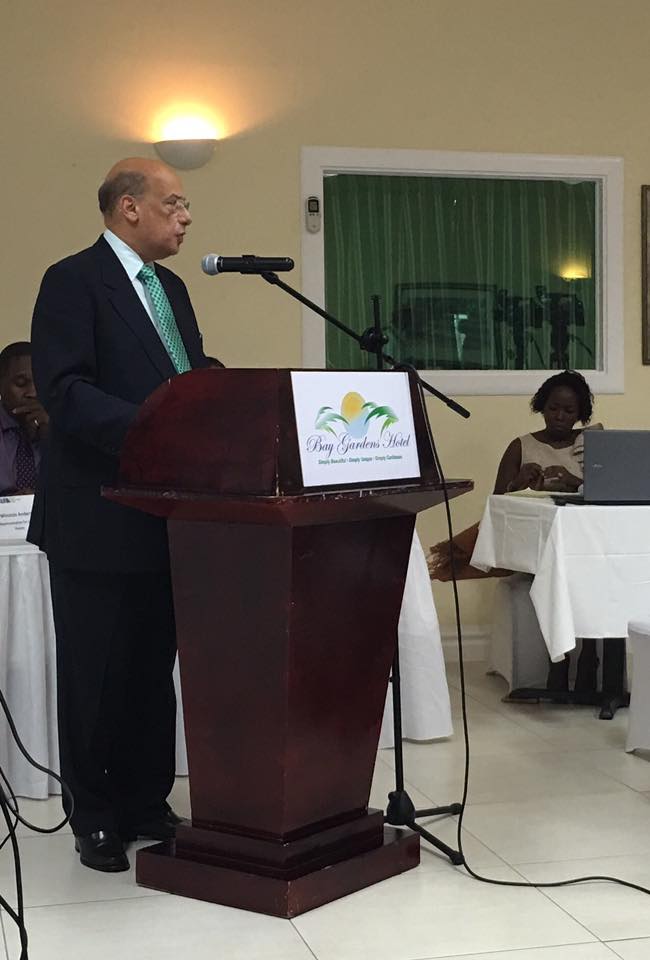Address by Sir Ronald Sanders To the Annual General Meeting of the St Lucia Hotel and Tourism Association
Address by Sir Ronald Sanders To the Annual General Meeting of the St Lucia Hotel and Tourism Association
 Thank you for the privilege of addressing your annual general meeting.
Thank you for the privilege of addressing your annual general meeting.
Occasions, such as this, are important for reviewing past performances, analysing current conditions and determining actions for the future.
In this presentation, I hope to place the agenda for your meeting in a regional and international context.
This is an extraordinary time, requiring extraordinary responses not only for the tourism industry but for the economies of the Caribbean Community (CARICOM) individually and collectively.
Right now, the world faces a high degree of political and economic unpredictability.
In the United States, the Caribbean region’s biggest trading partner and the country from which a large number of tourists come, there is great uncertainty over its future direction.
Will America become a fortress, ripping up trade agreements; closing its market; denying entry to immigrants, and forcing its business community to operate only in their domestic market, or will a more internationalist approach prevail – one in which the US continues to be an open economy that encourages liberalised trade and transnational investment?
Will the European Union with which the Caribbean has a complex relationship in aid, investment and tourism have less enthusiasm for the English-speaking Caribbean should Britain vote in its referendum next month to leave the EU?
How will China and Russia respond to these developments, and just how unstable could the world become unless the Presidential elections in the US and the Referendum in Britain reaffirm the value of internationalism and economic integration?
And how much longer will terrorism continue to stalk the globe, creating a climate of fear and generating expanding regimes of security that adversely impact travel and tourism?
These are all legitimate questions for your meeting to consider; not to paralyse your efforts but to galvanise action to counter challenges and seek out opportunities.
ooOoo
I know many of you are encouraged by what looks like good tourist arrival figures for the first quarter of the year.
Your cheer is understandable.
In the tourist sector in St Lucia, you have worked hard to achieve these numbers, and you have done so against considerable odds.
Last February, the International Monetary Fund, in its assessment of the St Lucia economy, stated quite clearly that it is “on the back of strong tourism inflows and lower oil prices, the St. Lucian economy has returned to growth after experiencing a recession in 2012 and close-to-zero growth in 2013. GDP growth reached 0.5 percent in 2014, with transportation and hotels mostly contributing to the economic recovery”.
Among the hurdles around which you and other CARICOM tourism operators have manoeuvred are:
- High taxes on air fares, including the Air Passenger Duty (APD) which continues to be imposed by the British government, and taxes on air travel by Caribbean governments. These fares make air travel to CARICOM countries – and between them – expensive and prohibitive;
- Increased and increasing competition from within the Caribbean, especially the Dominican Republic and Cuba;
- High costs to deliver a quality product to your clients, especially for water and electricity.
Amid all this, greater pressure is put on the tourism sector to deliver employment, revenues and foreign exchange.
Indeed, tourism, on average, now accounts for a significant percentage of the Gross Domestic Product of CARICOM countries taken as a whole.
In this connection, the tourism industry has to be seen in the context of CARICOM whose deficiencies in governance and operation mar the promises that it held out to the people of its member states.
ooOoo
I start with the now proven premise that no CARICOM nation is able to prosper on its own.
No protestations to the contrary erase the evidence that, without aid from external sources, these countries could not deliver the goods and services that their people expect.
Among such goods and services are: infrastructure like roads, bridges, ports, well- equipped school buildings and hospitals; education and health care; safety internally and security of borders; proper administration of justice; effective representation in the international community, including in trade and other negotiations; and the means to make and attract investment in every sector of their economies.
The countries of CARICOM started the process to their separate independence 54 years ago when Jamaica and Trinidad and Tobago became nominally sovereign states in 1962.
This year marks the 50th anniversary of independence for Guyana and Barbados.
Indeed, in exactly one week from today, Guyana will be marking its independence jubilee, and Barbados will follow in November.
Yet, while rightly they have shed colonial rule and assumed control of their affairs, after half a century of sovereignty in not one of these countries – or the others that followed them – is the picture rosy.
The opposite is true – each is being severely challenged, and the economic prospects for all appear gloomy.
A Commonwealth report on small states, just published, says that on its current development path, the Caribbean in 2050 will face unmanageable debt, poor growth, and greater socio-economic problems.
The report – Achieving a Resilient Future for Small States: Caribbean 2050 – considers current policies and trends in seven Caribbean countries – Bahamas, Barbados, Jamaica, St Lucia, Grenada, Trinidad and Tobago and Guyana – and makes a 34-year projection across different sectors.
The research shows five out of the six countries under study would have a debt-to-gross domestic product (GDP) above 100 per cent while two of them could exceed 200 per cent – dangerous levels if growth continues to lag.
These projections suggest that expenditure of debt interest will probably become a major drain on public finances in the future, reducing the funds available for development and giving rise to greater socio-economic problems.
Indeed, the Economic Commission for Latin America and the Caribbean puts the total debt burden of the of Caribbean countries in 2014 at US$49 billion or a whopping 70% of GDP.
It is a serious regional issue, particularly as it affects sovereign credit rating and has led to higher sovereign risk premiums in international capital markets which mean borrowing costs for Caribbean countries are very expensive.
It was precisely to meet these circumstances more effectively that in 1973 CARICOM was created and before it CARIFTA.
The leaders, at the time, recognised that while rightful separation from Britain gave them domestic political independence, none of them – not even Guyana with its vast natural resources or Trinidad and Tobago with its oil and gas – could prosper on their own.
CARICOM was created as the framework for pooling the individual sovereignties of member states; as the umbrella that would shelter then from the worst of economic storms; as the vehicle through which they would bargain internationally; as the foundation upon which structures of co-operation would be built to deliver their individual and collective betterment.
But, sadly, CARICOM wandered from its purposes.
The unity that was envisaged as the locomotive for delivering benefits was derailed by proclamations of nationalism and the sanctity of sovereignty.
An illusion of national success, particularly in the 1980s, gripped countries that mistakenly believed that preferential access to markets in Europe and North America and a steady stream of aid could last forever.
They misread the reality of cold war politics between Western nations and the Soviet Union in which the Caribbean was a strategically important location.
Once the cold war ended, the Caribbean’s importance fell away and with it their economies that then became exposed to an international community in which small states were marginal to the political and economic interests of big and powerful nations.
By the 1990s, it was clear that the Caribbean was in danger of becoming a back water.
The 1992 West Indian Commission Report, “Time for Action”, was a recognition of the dangers confronting the region, and the centrality of putting back on track the locomotive of integration.
The Commission recommended:
- Deepening economic integration through the creation of a Single Market and Economy so as to draw, for the common good, on the resources of the entire region – human, capital and know how;
- Strengthening the institutions of governance and operations of CARICOM by the establishment of a Caribbean Commission to implement decisions of Heads of Government and Ministers.
Reflecting on the central message of its recommendations, the Chairman of the West Indian Commission, Sir Shridath Ramphal, poignantly stated:
“We must not be left behind – and many of our recommendations offered the means go forward. But, the Commission was unequivocal: we must go forward in unity. Regionalism, integration, are at the heart of getting our act together”.
In the ensuing years, the CARICOM ship slipped from its moorings and is now in danger of fragmenting into separate small boats adrift in a perilous sea.
Today the Single Market has been on pause for five years, and the Single Economy has been all but abandoned.
Governments are each trying to go it alone, striking other alliances where they secure immediate benefits, and often, by doing so, weakening the cohesion of CARICOM.
ooOoo
The point is that, on all sides CARICOM member states are buffeted by economic forces with which they cannot contend alone, and against which they lack a strong and empowered single regional capacity to fight together.
Among the unfavourable conditions with which they contend are:
- World Trade Organisation rules that treat them the same as the United States, Canada, India and Brazil, giving them no special and differential treatment despite their smallness and vulnerabilities;
- Graduation in the international community from access to concessional financing;
- Deteriorating economic conditions in CARICOM countries including high debt and poor credit ratings, worsening terms of trade for goods; and
- The withdrawal from Caribbean banks of correspondent banking relations by banks primarily in the US – an action that has already had high cost effects on trade, including tourism.
The latter point is worth an address on its own.
But, suffice to say here that the problem – euphemistically called ‘de-risking’ – is real and requires unrelenting action by CARICOM governments and the private sector, including the tourism sector which needs local banks to have correspondent relations in order to transact business and specially to collect tourism receipts.
This is not somebody else’s problem; it is also yours.
ooOoo
Then, there is Climate Change which poses a clear danger to the survival of many Caribbean countries, including this one.
If global warming is not contained to no more than 1.5 degrees Celsius above pre-industrial levels, the coastal areas of many Caribbean countries will be severely eroded by sea-level rise.
At the Climate Change conference in Paris (COP21) last December, Caribbean Environment Ministers, fought valiantly for that objective as they did for money to fund mitigation and adaptation.
Had they not been as defiant as they were, the Agreement would have been worse than it is.
The agreement provides no firm, legally binding commitment to limit average global temperature increases to 1.5 degrees Celsius.
In truth, the climate change action plans submitted by 188 countries would lead to a temperature rise as high as 2.7 degrees Celsius.
Also not in the agreement is a legally binding commitment to provide developing countries with the funds needed to adapt to, and mitigate against, the effects of climate change.
As for money for mitigation and adaptation, the Green Climate Fund (GCF) allocates 25% of its financing for adaptation activities in small island states, Less Developed Countries and African states, but as at November 2015 only US$35.7 billon was pledged and a only a mere 52% deposited.
Even more distressing, of what has actually been deposited, only US$14.3 billion has been approved for projects, and of that sum a paltry 1% or US$700 million has so far been approved for projects in all of Latin America and the Caribbean.
The Caribbean is at the very bottom, and its share would be inadequate for financing its needs
Yet, the while the Caribbean is among the greatest victims, it is the least among the polluters.
The unfairness is palpable; the cause for justice is compelling.
These are all legitimate questions for your meeting to consider.
They are real and they can affect your business, Hotels on coastal areas will be the first to be affected by sea level rise.
There is every good reason, therefore, for you to raise your voices locally, regionally and internationally against global warming and for a better deal for the Caribbean
ooOoo
Amid all this, greater demands are made on the tourism sector throughout CARICOM to deliver employment, revenues and foreign exchange as well as a competitive product.
Indeed, tourism, on average, now accounts for a significant percentage of the Gross Domestic Product of CARICOM countries taken as a whole.
All that I have just described is the context in which tourism in CARICOM countries is functioning.
Clearly, there is an urgency for CARICOM countries as a whole to address their fragile condition, and to recognize that while national initiatives are imperative for economic growth and development and must be pursued diligently, deeper regional collaboration, including economic integration, hold beneficial and sustainable solutions.
Reinvigoration of CARICOM has all the urgency of now.
Continuing to neglect it, and only to pay lip service to it in ritualistic meetings and wordy press conferences, will hasten the process of decline and adversely impact every sector of the economies, including tourism.
Toward the end of this presentation, I will return to the issue of what might be done to reinvigorate CARICOM as a crucial player in the affairs of each and all of its member states.
ooOoo
Now it is to specific concerns in the tourism industry to which I turn, as much as to underscore the real challenges with which all CARICOM states are faced, as to sound a warning to you about the survival of your industry.
Let me first acknowledge that, despite all those who often dismiss tourism as “too fragile” to be a real player in the economic development of the Caribbean, the industry has emerged as a strong and resilient economic activity that has been a fundamental contributor to global economic recovery by generating billions of dollars in exports and creating millions of jobs.
It has played the same role in many CARICOM countries, including, as I pointed out earlier, this one – St Lucia.
The UN World Tourism Barometer has reported that tourism receipts increased by US$48 billion in 2014 to reach a record US$1.2 trillion globally.
An additional US$221 billion was generated from international passenger transport, bringing the total export earnings from international tourism to US$1.5 trillion.
Remarkably, the Americas was the highest growth area for tourism in the world.
And while the lion’s share of receipts – US$210 billion – went to North America, the second highest share was earned by the Caribbean, though only US$27 billion.
Still, the Caribbean was ahead of all of South America and ahead of all of Central America – quite an accomplishment for the region.
But, the biggest beneficiaries in the Caribbean area were the Dominican Republic, Puerto Rico, and Cuba.
Between them, they accounted for almost half of the money earned.
Let us remember the three lead countries: Dominica Republic, Puerto Rico and Cuba.
Nine years ago, I wrote a commentary that was widely published.
It was entitled, “The Big Three and Little CARICOM”.
This is what I said in the commentary:
“By any objective analysis, the US embargo of Cuba will be lifted within the next decade.
US companies want a significant piece of the Cuban action which they now see going to European and Canadian companies, and increasingly to China and Russia.
When the embargo is lifted, the Caribbean will be a very different place.
It would be one in which its two largest countries with populations of 20 million would be Spanish-speaking and of far greater importance to the global community than the little countries of CARICOM.
It is only the US trade embargo against Cuba that now prevents an integrated relationship between Cuba and the Dominican Republic in the Caribbean that would dwarf CARICOM.
Then, there is Puerto Rico – another island territory in the Caribbean with a population of 3.9 million that is Spanish-speaking.
Even if Puerto Rico does not seek separation from the US, once the embargo on Cuba is lifted, the deepening of economic relations between Puerto Rico, Cuba and the Dominican Republic would make perfect sense.
The Caribbean will then be dominated by these “big three” – with markets and investment opportunities far greater than all the CARICOM countries.
CARICOM countries would delude themselves if they believe that with their individual small markets, high investment costs, high costs of doing business and vulnerabilities both to natural disasters and external economic shocks – such as the current global financial meltdown – they could each operate successfully in the global market place in competition with the “big three”.
I ended the commentary by warning that:
“CARICOM governments would do well to bolster their economies and their capacity for dealing with their Caribbean neighbours and the international community by urgently completing the arrangements for implementing their own Single Market”.
And I urged that:
CARICOM member states “should also swiftly reform the governance of CARICOM which sorely needs overhaul”.
Mr Chairman, that deeper economic relationship between the Spanish-speaking Caribbean countries is now coming to pass, threatening to leave CARICOM behind.
Two weeks ago, my friend, colleague and analyst of Caribbean affairs for many years, David Jessop, pointed out that “work is progressing on studies on the creation of a new Caribbean economic block that might bring together Puerto Rico, the Dominican Republic and Cuba with objective of uniting the Spanish-speaking Caribbean and capitalising on new trade opportunities”.
He quoted Carlos Rivera Velez, the President of the Puerto Rico Association of Industries as saying:
“We hope that in the not too distant future, we can see the Dominican Republic, Puerto Rico and Cuba working together as a productive economic block for each of our countries and to strengthen the region”.
Jessop observed that “these developments are taking place as CARICOM has become less coherent… where ‘dysfunction and strife’ now militates against the spirit of the Caribbean integration movement”.
And he concluded, in terms similar to my own statement nine years ago, that: “It is time for the English speaking Caribbean as a whole to develop new thinking about how best to incorporate a future open trade relationship with Cuba, the Dominican Republic, and Puerto Rico, in ways that that deepen in the longer term trade with neighbours in Central and South America. It is time to read the writing on the wall”.
Clearly there is a need for a response from CARICOM countries collectively to the economic co-operation process that is being launched with vigour in their own front yard, or they will fulfil the fears that led to the creation of the West Indian Commission in 1990.
That fear was that: “against that background of historic change and historic appraisal, CARICOM countries could be in danger of becoming a backwater, separated from the main current of human advance into the 21st Century”.
This is a task for governments certainly; but not for governments alone.
The private sector, too, has to assume responsibility; first to solidify and strengthen their own positions, and then to explore ways of engaging the emerging alliance between Cuba, the Dominican Republic and Puerto Rico.
Specifically, in regard to tourism, it has become a comfort zone for many decision makers in the industry in CARICOM to proclaim that we have nothing to fear from the lifting of the US embargo against Cuba.
In my view, those who retreat behind this refrain ignore a huge elephant in the room.
Here are a few facts that illustrate my point:
- US airlines will begin direct commercial flights to Cuba this year. Already, airlines have applied for routes into several Cuban areas. American Airlines alone wants 10 flights a day from Miami to Havana. There are another 100 routes for which airlines such as America, Jet Blue, Delta, Eastern and United are scrambling.
- Cuba is a market of 11 million people. As its economy grows and the purchasing capacity of its population increases, its attractiveness as a place for investment, including in tourism, will rise correspondingly. Located just 90 miles from the US, it is also what US President Barack Obama called “a natural trading partner”.
- This month, more than 700 passengers went to Cuba from the US on board the Adonia, a boat that’s part of the Carnival fleet – the first in more than 50 years – and the start of many more.
- Norwegian Cruise Line wants to offer cruises to Cuba by the end of the year; the Miami-based company is already seeking approvals to sail there.
- Cuba received a record 3.52 million visitors last year, up 17.4 percent from 2014. American visits rose 77 percent to 161,000, not counting hundreds of thousands of Cuban-Americans.
- The tourism infrastructure, including with just 63,000 hotel rooms nationwide, has languished, but now the government is seeking more foreign investment and has plans to reach 85,000 hotel rooms by 2020. At the end of this exercise, Cuba will have updated, fresh and appealing infrastructure.
Even with the embargo still in place, Cuba is already a strong competitor for the rest of the Caribbean in tourism.
Once the embargo goes fully, in some measure the rest of the Caribbean will suffer from the diversion of US resources – both private and public – into Cuba.
As for the Dominican Republic, that country plans to Build 18,000 new hotel rooms by 2019, comprising 55 new hotel projects and more than $2 billion worth of investments.
Now, of all the CARICOM countries, Jamaica has recognised the potential benefits of a tourism alliance with Cuba and the DR.
It plans to forge a Multi-Destination Arrangement between Jamaica, Cuba and the DR. A memorandum of understanding is planned for this month.
Interestingly, the Jamaica Minister of Tourism announced that “there is also the possibility of Russia becoming a part of this arrangement which will see airlift arrangements between Russia, Cuba, Jamaica and the Dominican Republic.”
These arrangements make perfect sense for Jamaica located, as it is, in close proximity to the Spanish-speaking islands.
But, one has to wonder whether the deficiencies in the CARICOM integration process and its failure to deliver its objectives after 43 years of existence, has not contributed to encouraging Jamaica to seek alternatives which are not limited to tourism.
No one can blame Jamaica for taking a sensible initiative, but it would have benefitted CARICOM to enter these arrangements together.
It is what CARICOM governments should have been contemplating for some time now in collaboration with the Caribbean Hotels and Tourism Association (CHTA).
It took the Cuban Vice Minister of Tourism, Luis Miguel Diaz Sanchez, earlier this month to express to the Caribbean Hotels and Tourist Association a strong desire to see the region cooperate in building a stronger Caribbean brand.
Encouragingly, the CHTA said they “will be pursuing a number of priority issues discussed during their meetings” with the Cubans.
No time should be lost in pursuing these priorities; time is not on CARICOM’s side even if, at this point, there is goodwill from the Cubans.
Such goodwill will not last forever, and Cuba’s national interest will respond to change and the lure of other sirens.
ooOoo
I now make two other points.
The first is that there is an obvious need for diversification of the markets from which CARICOM countries seek tourists.
For years, CARICOM governments have talked about opening markets in China and Japan, but no meaningful action has been taken, largely because it is up to the tourism private sector to do so.
Today, in outward tourism, China is the world’s top spender with a 28% increase in 2014, reaching a total of US$165 billion.
Why would CARICOM countries neglect a share of that significant sum of money?
There is now a great opportunity, through multi-destination arrangements with Cuba, to tap into the Chinese market.
The opportunity lies in the reality that Air China now flies directly from Beijing to Havana.
The number of Chinese tourists in Cuba surpassed 25 thousand last year.
A market and an opportunity exist.
As we look at the state of tourism in CARICOM today and the vital role it is playing in the majority of CARICOM countries and that it could play in all of them, it is significant that there is no structured meeting of CARICOM Ministers of Tourism.
Meetings of Tourism Ministers should become an organ of CARICOM, enshrined in the Treaty similar to Ministers of Foreign Affairs and Ministers of Trade.
It is time that this missing link be corrected, and I hope that you will encourage your colleagues in the Caribbean Hotels and Tourist Association to call for it.
ooOoo
It is also time that the countries of CARICOM- acknowledge that there is a loss of momentum with regard to the regional integration agenda.
There is a deep sense of dissatisfaction with the ambling pace of CARICOM integration and especially with the large gap between decisions it takes and the implementation of such decisions.
The scepticism and disillusionment resulting from the ‘Implementation Deficit’ of the last decade has already undermined the previous three decades of work.
Lack of confidence in CARICOM is causing member states to establish alliances elsewhere.
These issues need to be addressed as a matter of urgency.
The next CARICOM Heads of Government Conference is 6 weeks away.
It would be appropriate, desirable, and important for the Conference to address how best they might establish mechanisms to halt the decline in CARICOM and return to making it an instrument of development and progress for each of its countries and all of them.
You in the tourism sector are playing your part, as is evident from your performance and the important contribution you are making to the economic well-being of St Lucia.
But from this place, and at this meeting, you would do yourselves, your businesses and CARICOM a great good by calling on all decision makers to recommit themselves in deed, more than in words, to the objects of regional integration, including how CARICOM as a whole can integrate its economic efforts with other nations in the Caribbean.
Nearly 25 years ago the West Indian Commission observed that:
“The widening of integration in the Caribbean is necessary, both in itself and for enlarging the gains of integration… a widening process may well spur us to action in strengthening the integration bonds between our founding West Indian partners… CARICOM region keeps on affirming that this is our intent; but we fulfil it at a pace so halting that it almost resembles retrogression.”
It was ‘time for action’ then; it is manifestly time for action now.
Thank you.
Recent Posts
Tags




